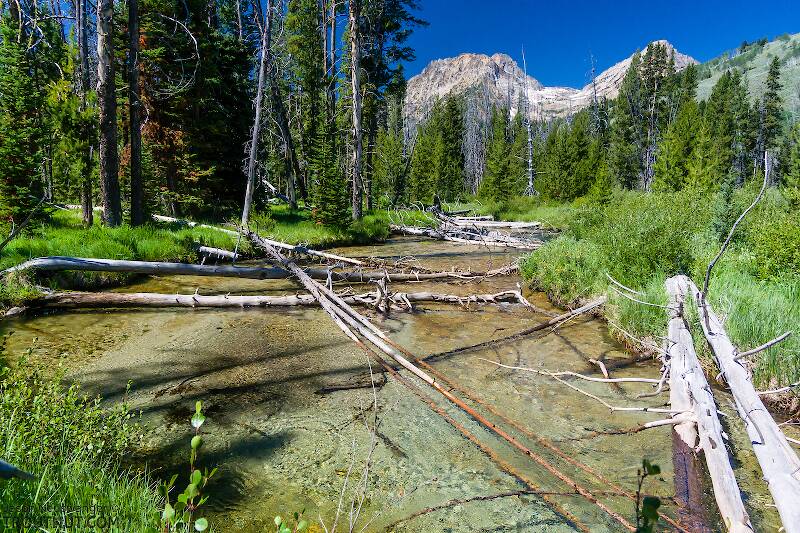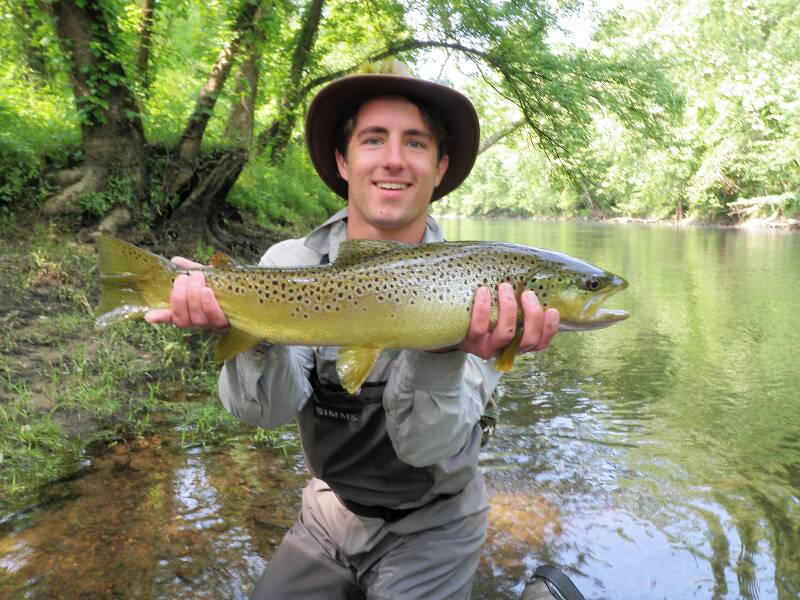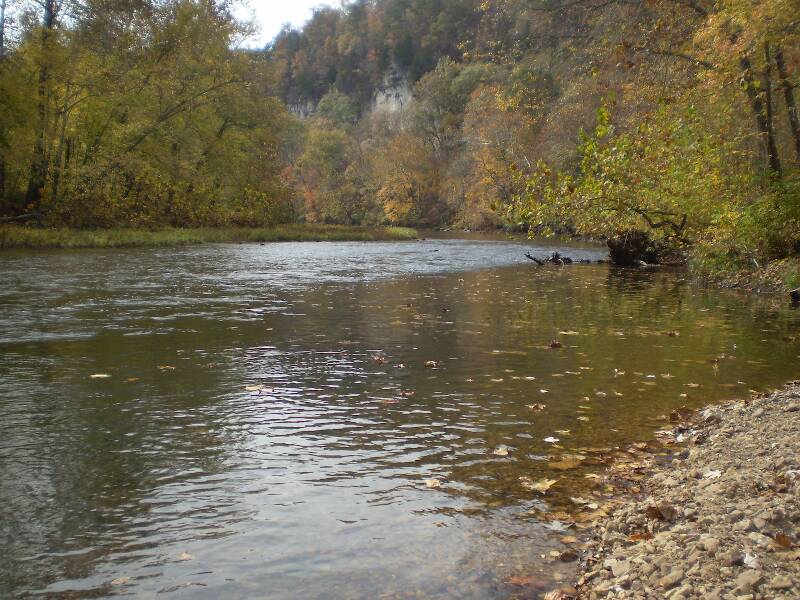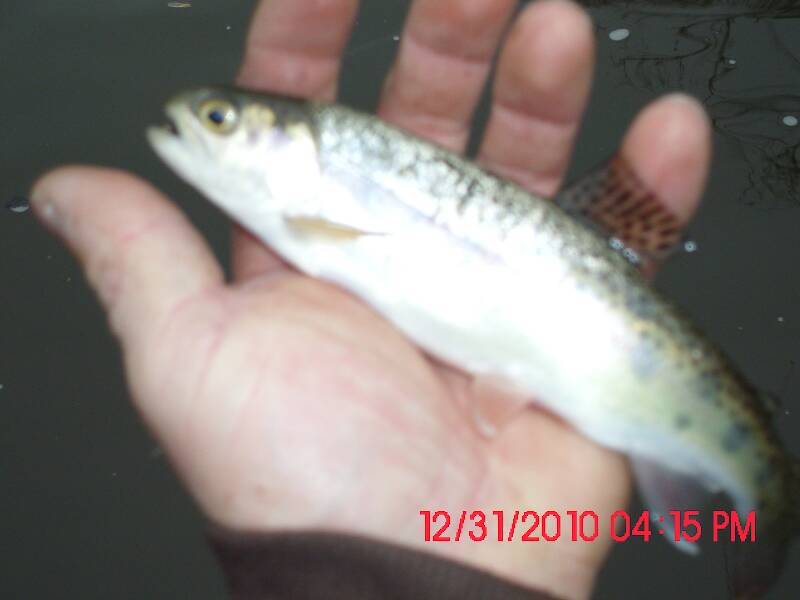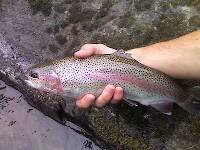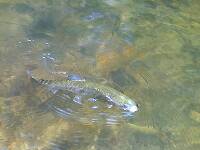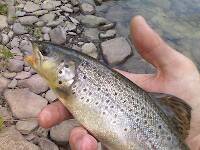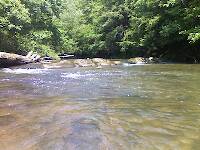
Blue-winged Olives
Baetis
Tiny Baetis mayflies are perhaps the most commonly encountered and imitated by anglers on all American trout streams due to their great abundance, widespread distribution, and trout-friendly emergence habits.
Featured on the forum


Troutnut is a project started in 2003 by salmonid ecologist Jason "Troutnut" Neuswanger to help anglers and
fly tyers unabashedly embrace the entomological side of the sport. Learn more about Troutnut or
support the project for an enhanced experience here.
Jesse on Jan 2, 2011January 2nd, 2011, 2:30 pm EST
Heya guys/grils i just wanted to hear some of your thoughts on stocked trout reproduction:
is it possible?
common occurence?
the chances of survival?
any other factors or information?
is it possible?
common occurence?
the chances of survival?
any other factors or information?
Most of us fish our whole lives..not knowing its not the fish that we are after.
http://www.filingoflyfishing.com
http://www.filingoflyfishing.com
Jmd123 on Jan 2, 2011January 2nd, 2011, 6:25 pm EST
Well Jesse, it probably depends on what the purpose of the stocking is for. Any healthy trout is going to try to reproduce, it's just their genetic programming, but the conditions have to be right for it to be successful. A substantial amount of stocking in this contry is for "put-and-take" fisheries, where the fish aren't likely to survive or reproduce successfully in the long term so they are replaced by hatchery stock every season. On the other hand, some fisheries are stocked for reintroduction/rehabilitation and of course the intention there is to re-establish a self-sustaining, self-reproducing population that doesn't need the constant restocking.
I suspect that your question may pertain to stocked trout in fisheries where wild fish are already present. Most stockers in such an environment are at a competetive disadvantage compared to fish that were born in that particular stream and have, through natural selection, become adapted to local conditions and survival compared to fish raised in the nice predator-free food-filled environment of a hatchery. However, stocking of rainbow trout throughout the west has caused the decline of numerous races of native cutthroat through hybridization, meaning those stockers are mating and reproducing (most unfortunately).
Obviously, there are lots of trout today in places where trout never existed before (e.g., the south), and many of these populations are self-sustaining. I have fished a beautiful little creek in southwest MO (don't worry Motrout, I won't give it away but you know where I'm talking about) that was supposedly stocked once back in the late 1800s and never again, and now has a jealously guarded (no kill, artificials only) population of what are stated to be pure strain redband rainbows from California.
I hope this helps but you may already know most of what I have said! I guess another example is the Chattahoochee River in the Atlanta, GA area. This river is stocked every winter and some (not many) of the rainbows and a few browns do holdover, in spite of severely excessive water temps - there are probably a few cold water springs that provide refugia in what is otherwise strictly a warm-water system. However, I heard from a fellow fisherman and colleague that little trout, considerably smaller than the stocking size, had been found in the river, meaning...reproduction! So, if they can, they will...
Jonathon
I suspect that your question may pertain to stocked trout in fisheries where wild fish are already present. Most stockers in such an environment are at a competetive disadvantage compared to fish that were born in that particular stream and have, through natural selection, become adapted to local conditions and survival compared to fish raised in the nice predator-free food-filled environment of a hatchery. However, stocking of rainbow trout throughout the west has caused the decline of numerous races of native cutthroat through hybridization, meaning those stockers are mating and reproducing (most unfortunately).
Obviously, there are lots of trout today in places where trout never existed before (e.g., the south), and many of these populations are self-sustaining. I have fished a beautiful little creek in southwest MO (don't worry Motrout, I won't give it away but you know where I'm talking about) that was supposedly stocked once back in the late 1800s and never again, and now has a jealously guarded (no kill, artificials only) population of what are stated to be pure strain redband rainbows from California.
I hope this helps but you may already know most of what I have said! I guess another example is the Chattahoochee River in the Atlanta, GA area. This river is stocked every winter and some (not many) of the rainbows and a few browns do holdover, in spite of severely excessive water temps - there are probably a few cold water springs that provide refugia in what is otherwise strictly a warm-water system. However, I heard from a fellow fisherman and colleague that little trout, considerably smaller than the stocking size, had been found in the river, meaning...reproduction! So, if they can, they will...
Jonathon
No matter how big the one you just caught is, there's always a bigger one out there somewhere...
Oldredbarn on Jan 3, 2011January 3rd, 2011, 6:56 am EST
Jonathon,
Nice post there, man!
Spence
Nice post there, man!
Spence
"Even when my best efforts fail it's a satisfying challenge, and that, after all, is the essence of fly fishing." -Chauncy Lively
"Envy not the man who lives beside the river, but the man the river flows through." Joseph T Heywood
"Envy not the man who lives beside the river, but the man the river flows through." Joseph T Heywood
Jmd123 on Jan 3, 2011January 3rd, 2011, 7:10 am EST
Thank you Sir - I can get a little long-winded myself, especially late at night (check the posting time!) and a few glasses full...
Jonathon
Jonathon
No matter how big the one you just caught is, there's always a bigger one out there somewhere...
Motrout on Jan 3, 2011January 3rd, 2011, 12:21 pm EST
I see wild trout in stocked fisheries on a very regular basis. One river I'm thinking of specifically is the Current River. In its twenty miles of trout water, the Current receives about 120,000 trout per year, about 100,000 of those being stocked in first three miles of the river which is a "trout park" (meaning it is stocked daily March 1-October 31). Despite these truly massive numbers of stocked fish, I still catch wild rainbows on a pretty regular basis. One interesting thing that I find is that the wild rainbows tend to hold in different water than the stockers. The stockers are usually found in the deep runs and pools, while I find the wild rainbows concentrated in the shallow riffles where the stockers don't compete with them as much. I suspect that stream could become an excellent wild trout fishery if they didn't dump a whole hatchery in it every year. It kinda strikes me a waste of what could be one of the best trout streams in the country.
"I don't know what fly fishing teaches us, but I think it's something we need to know."-John Gierach
http://fishingintheozarks.blogspot.com/
http://fishingintheozarks.blogspot.com/
Benjlan on Jan 3, 2011January 3rd, 2011, 3:18 pm EST
Hey Ya'll,
Pardon my lack of knowledge but how do you tell a wild trout from a stocked trout. I know stockies don't have all their fins in tact, but don't they grow back with time? I've caught some perfect looking trout here in Iowa big fins not a scar on them, could they be wild or perhaps just in the stream for a long time? Like I said just asking, not a very smart ff, just enjoy it.
Ben
Pardon my lack of knowledge but how do you tell a wild trout from a stocked trout. I know stockies don't have all their fins in tact, but don't they grow back with time? I've caught some perfect looking trout here in Iowa big fins not a scar on them, could they be wild or perhaps just in the stream for a long time? Like I said just asking, not a very smart ff, just enjoy it.
Ben
Jmd123 on Jan 3, 2011January 3rd, 2011, 5:49 pm EST
Well, if they're planted small enough and get to grow up in the stream, it's hard to tell the difference once they're bigger. Some studies have shown that it is the hatchery DIET, lacking in copper which is found naturally in insect "blood" (more properly called hemolymph), that causes the deformed fins and dull colors. Once they're living in the stream eating bugs instead of Purina Fish Chow, well, everything changes...
Jonathon
Jonathon
No matter how big the one you just caught is, there's always a bigger one out there somewhere...
Motrout on Jan 4, 2011January 4th, 2011, 1:10 am EST
I am not sure how to reliably tell adult wild trout from stocked trout...Although if they have white fin tips, and are brilliantly colored, that's at least a clue that they're wild-and by the same token, if they're beat up and drably colored, it's probably a stocker. But that's not at all surefire, as some stockers have fully formed fins and are colorful(especially those that have been in the stream awhile already), and some wild fish aren't very colorful for whatever reason.
But mainly, when I am trying to find out if there are any wild trout in a stocked stream system, I look for fish smaller than the minimum stocking size. In Missouri, that's about 10 inches, so I can pretty well assume that any fish smaller than that was born in the stream. But even that isn't an entirely fool proof method, as undoubtedly sometimes hatchery workers accidentally scoop up a few fish that are smaller than the usual minimum stocking size.
Some states clip fins on hatchery fish to make the distinction easier.
But mainly, when I am trying to find out if there are any wild trout in a stocked stream system, I look for fish smaller than the minimum stocking size. In Missouri, that's about 10 inches, so I can pretty well assume that any fish smaller than that was born in the stream. But even that isn't an entirely fool proof method, as undoubtedly sometimes hatchery workers accidentally scoop up a few fish that are smaller than the usual minimum stocking size.
Some states clip fins on hatchery fish to make the distinction easier.
"I don't know what fly fishing teaches us, but I think it's something we need to know."-John Gierach
http://fishingintheozarks.blogspot.com/
http://fishingintheozarks.blogspot.com/
CaseyP on Jan 4, 2011January 4th, 2011, 1:53 am EST
some fisheries are stocked for reintroduction/rehabilitation and of course the intention there is to re-establish a self-sustaining, self-reproducing population that doesn't need the constant restocking.--Jmd
ladies and gentlemen, i give you the (drum roll please!)...Little Juniata River in south-central PA.
http://www.littlejuniata.org/index.php
the website can give you some history, but to cut to the chase: stocked fingerlings with clipped fins, surveys of redds in early November, and electroshocking have all indicated that there is a thriving wild brown trout population in a river that was dead in the 1970s.
help me out here: who said "Eternal vigilance is the price of freedom"? the same is true of wild resources!
"You can observe a lot by watching." Yogi Berra
Oldredbarn on Jan 4, 2011January 4th, 2011, 3:03 am EST
help me out here: who said "Eternal vigilance is the price of freedom"? the same is true of wild resources!
Thomas Jefferson Casey...
Spence
"Even when my best efforts fail it's a satisfying challenge, and that, after all, is the essence of fly fishing." -Chauncy Lively
"Envy not the man who lives beside the river, but the man the river flows through." Joseph T Heywood
"Envy not the man who lives beside the river, but the man the river flows through." Joseph T Heywood
Softhackle on Jan 4, 2011January 4th, 2011, 5:50 am EST
I also know of a couple of tributaries to my home water where the state has stopped stocking because previous stockings have re-established populations of native brook trout. Every so often, we'll pick up one or two of these fish that have grown and moved into the river. It's really nice to see them.
Mark
Mark
"I have the highest respect for the skilled wet-fly fisherman, as he has mastered an art of very great difficulty." Edward R. Hewitt
Flymphs, Soft-hackles and Spiders: http://www.troutnut.com/libstudio/FS&S/index.html
Flymphs, Soft-hackles and Spiders: http://www.troutnut.com/libstudio/FS&S/index.html
RleeP on Jan 4, 2011January 4th, 2011, 8:35 am EST
Benjlan..
Here's a little help on Iowa trout and their origins, maybe...
1) With almost no exceptions, if you catch a rainbow in an Iowa stream, it is a stocked fish. The sole exception to this "might" be Coldwater Creek up NW of Decorah.
2) If you catch a brook trout in a regular (not put and grow program) Iowa trout stream, it is almost certainly a stocked fish unless you caught it out of South Pine Creek or the upper half of French Creek.
3) Brown trout origin in Iowa is getting trickier to discern every year as more and more Iowa streams are experiencing successful brown trout reproduction. In general, if you catch a healthy, well colored, full-finned brown out of a stream in Allamakee, Winneshiek or Clayton Counties, depending on the stream, there is a probably a 50/50 or better chance it is wild. And in quite a few streams, this rises to 75% to 100% (100% in one stream, anyway). I'm not going to name any streams here, but would be happy to talk with you via private message if you want to write me. I've spent a lot of time flailing Iowa streams over the past 5-6 years or so.
Otherwise, everything the guys here have been telling you about how to tell a wild fish by its appearance is pretty solid information.
Cheers!
Lee
Here's a little help on Iowa trout and their origins, maybe...
1) With almost no exceptions, if you catch a rainbow in an Iowa stream, it is a stocked fish. The sole exception to this "might" be Coldwater Creek up NW of Decorah.
2) If you catch a brook trout in a regular (not put and grow program) Iowa trout stream, it is almost certainly a stocked fish unless you caught it out of South Pine Creek or the upper half of French Creek.
3) Brown trout origin in Iowa is getting trickier to discern every year as more and more Iowa streams are experiencing successful brown trout reproduction. In general, if you catch a healthy, well colored, full-finned brown out of a stream in Allamakee, Winneshiek or Clayton Counties, depending on the stream, there is a probably a 50/50 or better chance it is wild. And in quite a few streams, this rises to 75% to 100% (100% in one stream, anyway). I'm not going to name any streams here, but would be happy to talk with you via private message if you want to write me. I've spent a lot of time flailing Iowa streams over the past 5-6 years or so.
Otherwise, everything the guys here have been telling you about how to tell a wild fish by its appearance is pretty solid information.
Cheers!
Lee
Jesse on Jan 4, 2011January 4th, 2011, 10:22 am EST
Very cool stuff so far everyone. You see i fish a lot in the southeast, mostly tailwaters where i am at (right outside of nashville, TN). I do get to the northeastern part of the state for some native brookie and brown fishing once in a while. Anyway i know a lot of the differences in wild and stocked fish; the rounded fins, deformed fins, discolorations, the brown trout red adipose and blue spotted gill plate and im sure there are many more that go along with those. Ive caught fish from stocked tailwaters that look more wild than the native fish ive caught elsewhere around the world, but so many people still insist that they cant be wild. Ive always thought that in many stocked tailwaters that are fisheable all year round can produce trout that can reproduce and eventually become wild. Like i said, so many people have misconceptions about it, and its great to hear all of the input.
Most of us fish our whole lives..not knowing its not the fish that we are after.
http://www.filingoflyfishing.com
http://www.filingoflyfishing.com
CaseyP on Jan 4, 2011January 4th, 2011, 12:57 pm EST
Thomas Jefferson, Casey...--Oldredbarn
thanks, Spence. sounds like him!
"You can observe a lot by watching." Yogi Berra
PaulRoberts on Jan 10, 2011January 10th, 2011, 4:27 am EST
Some stuff on stocked trout...
Stocked trout can usually be ID'd in several ways:
Fin Warping:
Unless stocked very young, stocked trout will have warped fins due to crowding (repeated physical contact) in hatchery raceways where they are raised in large numbers for cost efficiency reasons. The fins most apt to be warped are the dorsal and the pectorals. This does NOT grow out in later life. They may smooth out somewhat over time but always maintain a warp, esp near the base of the fin.
Flesh color:
Stockies, at least recently stocked, have white flesh. Streambred fish tend to be orange-ish (browns) and pinkish (bows). I assume this is due to diet. When you buy "Trout Almondine" in a fancy restaurant and see the white flesh you know it was pellet raised. Salmon farmers are wise to this and use additives in the diet to alter the color to something more "salmon-like".
Coloration:
When first released, stocked trout are often a silvery coloration bc they are in “migratory” mode, as they are not in an established home range. They tend to be more current/depth oriented. This silvery coloration can also be due to the fact that a lot of stocking occurs in early spring when water may be somewhat high and turbid. But the stocky pallor is different from streambred fish. Spring streambreds in migratory mode tend to still be colorful, browns often are still nicely spotted and often have a pale metallic yellow wash to the flanks. Stockies (browns) are olive green scattered with silver scales. When waters clear and darken the streambreads go stunning, the stockies maintain the olive drab -at least for their first year.
Streambred trout are more richly colored, matching stream bottoms and water and with the social markings they use when interacting with other trout on a home range. Stocked trout tend to remain more current and depth oriented until, or more accurately, if, they become acclimated to stream life. Even then, at least in the waters I've fished stockies never seem to gain the full coloration that streambred fish will. Dunno if this is always true but it seemed to be the case where I’ve fished.
Ecology/Behavior:
In many, esp marginal waters, stocked trout are too large for the drift potential of the stream they’ve been dumped in. It’s not that the stream cannot support trout of this size, but by the time they reach 9 to 12inches, streambred trout already know how to operate. Those that failed are history. Stocked trout come into most natural streams ill-equipped to eek out a living there. Competition is high due to the numbers stocked, and against streambred individuals already present. Some survive though, more in some streams than others. It seemed to me that many stocked trout that do survive in more marginal waters, do so by sheer aggression using pursuit feeding rather than drift feeding. I always noticed that in some marginal waters some of the larger trout were holdovers (surviving stockers). I also noticed stocked trout well downstream from classic trout waters, dropping into chub water or worse –smallmouth water downstream. I believe the fish just cannot find a niche and keep dropping downstream until they end up in larger warmer waters below. Most probably die, but if they bumble into a spring or cool trib, they might survive, and grow large down there. In keeping with this, my advisor in college, a fisheries prof, once told me of a study in which streambred and hatchery brown trout were marked and then released in a stream. The streambred fish ran upstream, and the stockies dropped down. You can imagine the different mortality suffered by those groups.
Reproduction? Throw enough stockies into a stream that offers production potential (temperature, oxygenated gravel, and nursery space) to begin with and you’ll have some success over time. But….if the stream is capable of production, the word is: stocking won’t help and may hurt nauturalized populations. Put-n-take is common though and serves the purpose of giving novices an introduction to stream fishing and gives those who don’t want to get in deep the opportunity to bring some fish home. Because of the general failure of stocked trout in most waters, this isn’t necessarily a bad thing for the fishery.
Stocked trout can usually be ID'd in several ways:
Fin Warping:
Unless stocked very young, stocked trout will have warped fins due to crowding (repeated physical contact) in hatchery raceways where they are raised in large numbers for cost efficiency reasons. The fins most apt to be warped are the dorsal and the pectorals. This does NOT grow out in later life. They may smooth out somewhat over time but always maintain a warp, esp near the base of the fin.
Flesh color:
Stockies, at least recently stocked, have white flesh. Streambred fish tend to be orange-ish (browns) and pinkish (bows). I assume this is due to diet. When you buy "Trout Almondine" in a fancy restaurant and see the white flesh you know it was pellet raised. Salmon farmers are wise to this and use additives in the diet to alter the color to something more "salmon-like".
Coloration:
When first released, stocked trout are often a silvery coloration bc they are in “migratory” mode, as they are not in an established home range. They tend to be more current/depth oriented. This silvery coloration can also be due to the fact that a lot of stocking occurs in early spring when water may be somewhat high and turbid. But the stocky pallor is different from streambred fish. Spring streambreds in migratory mode tend to still be colorful, browns often are still nicely spotted and often have a pale metallic yellow wash to the flanks. Stockies (browns) are olive green scattered with silver scales. When waters clear and darken the streambreads go stunning, the stockies maintain the olive drab -at least for their first year.
Streambred trout are more richly colored, matching stream bottoms and water and with the social markings they use when interacting with other trout on a home range. Stocked trout tend to remain more current and depth oriented until, or more accurately, if, they become acclimated to stream life. Even then, at least in the waters I've fished stockies never seem to gain the full coloration that streambred fish will. Dunno if this is always true but it seemed to be the case where I’ve fished.
Ecology/Behavior:
In many, esp marginal waters, stocked trout are too large for the drift potential of the stream they’ve been dumped in. It’s not that the stream cannot support trout of this size, but by the time they reach 9 to 12inches, streambred trout already know how to operate. Those that failed are history. Stocked trout come into most natural streams ill-equipped to eek out a living there. Competition is high due to the numbers stocked, and against streambred individuals already present. Some survive though, more in some streams than others. It seemed to me that many stocked trout that do survive in more marginal waters, do so by sheer aggression using pursuit feeding rather than drift feeding. I always noticed that in some marginal waters some of the larger trout were holdovers (surviving stockers). I also noticed stocked trout well downstream from classic trout waters, dropping into chub water or worse –smallmouth water downstream. I believe the fish just cannot find a niche and keep dropping downstream until they end up in larger warmer waters below. Most probably die, but if they bumble into a spring or cool trib, they might survive, and grow large down there. In keeping with this, my advisor in college, a fisheries prof, once told me of a study in which streambred and hatchery brown trout were marked and then released in a stream. The streambred fish ran upstream, and the stockies dropped down. You can imagine the different mortality suffered by those groups.
Reproduction? Throw enough stockies into a stream that offers production potential (temperature, oxygenated gravel, and nursery space) to begin with and you’ll have some success over time. But….if the stream is capable of production, the word is: stocking won’t help and may hurt nauturalized populations. Put-n-take is common though and serves the purpose of giving novices an introduction to stream fishing and gives those who don’t want to get in deep the opportunity to bring some fish home. Because of the general failure of stocked trout in most waters, this isn’t necessarily a bad thing for the fishery.
Quick Reply
Related Discussions
Topic
Replies
Last Reply
23
Aug 13, 2014
by Reelin_good
by Reelin_good
6
Dec 7, 2012
by Pryal74
by Pryal74
Re: East meets West: Todd's place on Cowden Lake, September 2020 


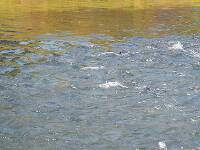
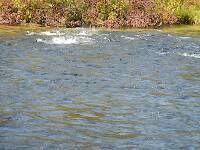
In the Photography Board by Jmd123
+ 14





In the Photography Board by Jmd123
3
Mar 3, 2021
by Roguerat
by Roguerat
12
Apr 27, 2015
by Patroutbum
by Patroutbum
4
Apr 9, 2008
by GONZO
by GONZO

